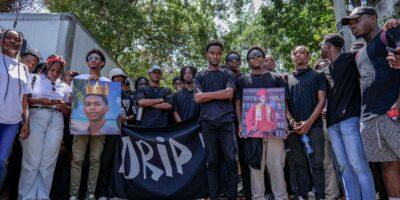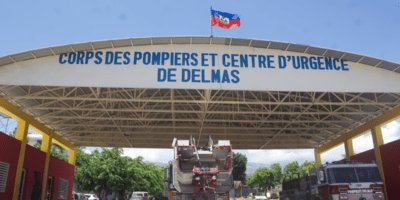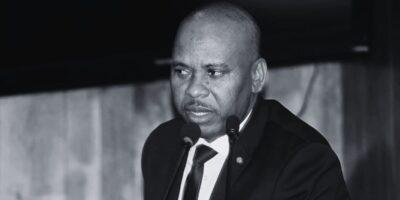Composed mainly of military personnel, the Investigation and Anti-Gang Service were meant to combat rampant criminality in the capital
The omnipotence of gangs throughout the country is fueling a debate surrounding the Haitian National Police’s (PNH) shortcomings and the merits of the decision to permanently close the « Investigation and Anti-Gang Service » (SIAG) in 2005.
The unit was supposed to combat rampant criminality in the capital.
The former PNH entity emerged from the Haitian Armed Forces (FADH) in the 1970s during the Duvalier dictatorship. Composed mainly of military personnel, the unit was meant to combat rampant criminality in the capital.
When the permanent closure of their offices took place under the administration of the former director of the PNH, Mario Andresol, the entity had a notoriously long history of abuses of power, slaughtering innocent people, and violently arresting political opponents.
Lire aussi : “On ne peut pas laisser des hommes armés avec autant de frustrations.”
The SIAG operated independently of the PNH, according to well-informed sources familiar with the entity’s operations. « I am intimately familiar with their methods of operation and the way they would torture citizens after arrests because I served within that entity for an entire year, » reveals a former PNH official.
This entity had a notoriously long history of abuses of power, slaughtering of innocent people, and violently arresting political opponents.
At the launch of the SIAG, Port-au-Prince, already overcrowded, was facing repeated assaults from criminals. As a response, Jean Claude Duvalier established the unit.
Lire aussi : Les « Duvalier » dans l’histoire d’Haïti : crimes, exécutions et injustice
The majority of SIAG personnel were composed of FADH soldiers, and they served a policing role in the outskirts of the capital, with no authority to intervene in provincial towns, according to Colonel Derby Guerrier, who is currently a high-ranking member of the FADH.
The SIAG quickly gained recognition as a deterrent force, especially at markets like Croix-des-Bossales, Bélair, and Grand-Rue in Port-au-Prince.
As a response, Jean Claude Duvalier established the unit.
However, political influence posed a threat: quickly, the SIAG began to « commit arbitrary arrests, » according to the former military official and ex high-ranking member of the PNH.
Due to the Duvalier regime’s culture of secrecy, it was difficult to determine the total number of SIAG personnel. Some of its members were active participants, while others served as informants for the institution in certain sensitive areas.
The less-than-democratic unit managed to avoid dissolution when the Duvalier dictatorship was overthrown in 1986.
The adventure wasn’t over, however. The Anti-Gang unit, which continued to operate, would become the sole structure of the Duvalier dictatorship and the only entity from the Haitian military to be integrated into the PNH in 1996.
It was difficult to determine the total number of SIAG personnel.
From then on, recruits were referred to as « detectives. » They resided in practically all neighborhoods of Port-au-Prince and served as informants to the PNH.
After the dismantling of the FADH in 1990, an interim police force was established with Dany Toussaint as its head. Approximately 3,000 FADH soldiers joined the ranks of this police force after a brief examination of their records and one week of training. This body would disappear in 1995 as young police officers graduated from the Police Academy, which opened its doors in February 1995.
The interim police force was declared defunct at the beginning of 1996, and over a thousand of its members then joined the new police force, as reported by our source.
After the dismantling of the FADH in 1990, an interim police force was established with Dany Toussaint as its head.
The majority of SIAG members possessed firearms and had the authority to make arrests.
« It was a bad practice because these people acted like mercenaries for the state, » according to the former military official and former high-ranking member of the PNH. « The agents had a torture device called the ‘dyak,’ on which they would place people to torture them. Other citizens were beaten or subjected to summary executions. »
Marie Yolène Gilles, executive director of the Je Klere Foundation, testifies that she was targeted by the arbitrary intervention methods of this entity when she was a journalist at Radio Cacique in 1992. During that time, SIAG operatives were tracking pro-Lavalas journalists.
At the time, the Anti-Gang unit was magnifying abuses in Port-au-Prince.
« I was part of a group of journalists who were unjustly arrested in April 1992 following the first coup against President Jean-Bertrand Aristide. We wanted to cover an event at the Cathedral of Port-au-Prince when the operatives initiated acts of retaliation against journalists who wanted to attend the event. »
At the time, the Anti-Gang unit was magnifying abuses in Port-au-Prince. Some political figures were arrested and violently beaten after being detained in their offices located at the corner of Rue des Casernes and Monseigneur Guilloux.
The SIAG was implicated in the assassination of Guy Malary, the late Minister of Justice appointed by former President Jean-Bertrand Aristide during his first term. He continued to serve in his role under the de facto military regime of Raoul Cédras. According to reports from human rights organizations of the time, Malary’s assassination was allegedly planned and carried out in Port-au-Prince on October 14, 1993, by security agents of the Haitian state’s military regime.
The Anti-Gang unit had retained intervention methods that were prevalent during the Duvalier dictatorship.
The SIAG was implicated in the assassination of Guy Malary, the late Minister of Justice.
While they instilled fear in petty criminals in Port-au-Prince, SIAG operatives had received military training that was incompatible with the policing role they were assigned.
If the unit were to be resurrected today, « it would be much more of a political weapon for the government against its opponents instead of being an entity in the service of the population, » posits the former military official and ex high-ranking member of the PNH.
Upon the closure of the SIAG’s offices, some of its members assumed different roles within the PNH. Others, including some older individuals, left the institution to express their discontent.
Lire aussi : D’où viennent réellement les gangs qui terrorisent Haïti ?
Les fonctions de l’Antigang sont aujourd’hui assignées au Bureau des affaires criminelles (BAC), une entité de la direction centrale de la police judiciaire (DCPJ).
English translation by Sarah Jean.
© Cover Photo: «One man was killed in central Port-au-Prince during the violence clashes | Andres Martinez Casares/Reuters »
Stay in touch with AyiboPost through :
► Our Telegram canal : click here
► Our WhatsApp Community : click here







Comments